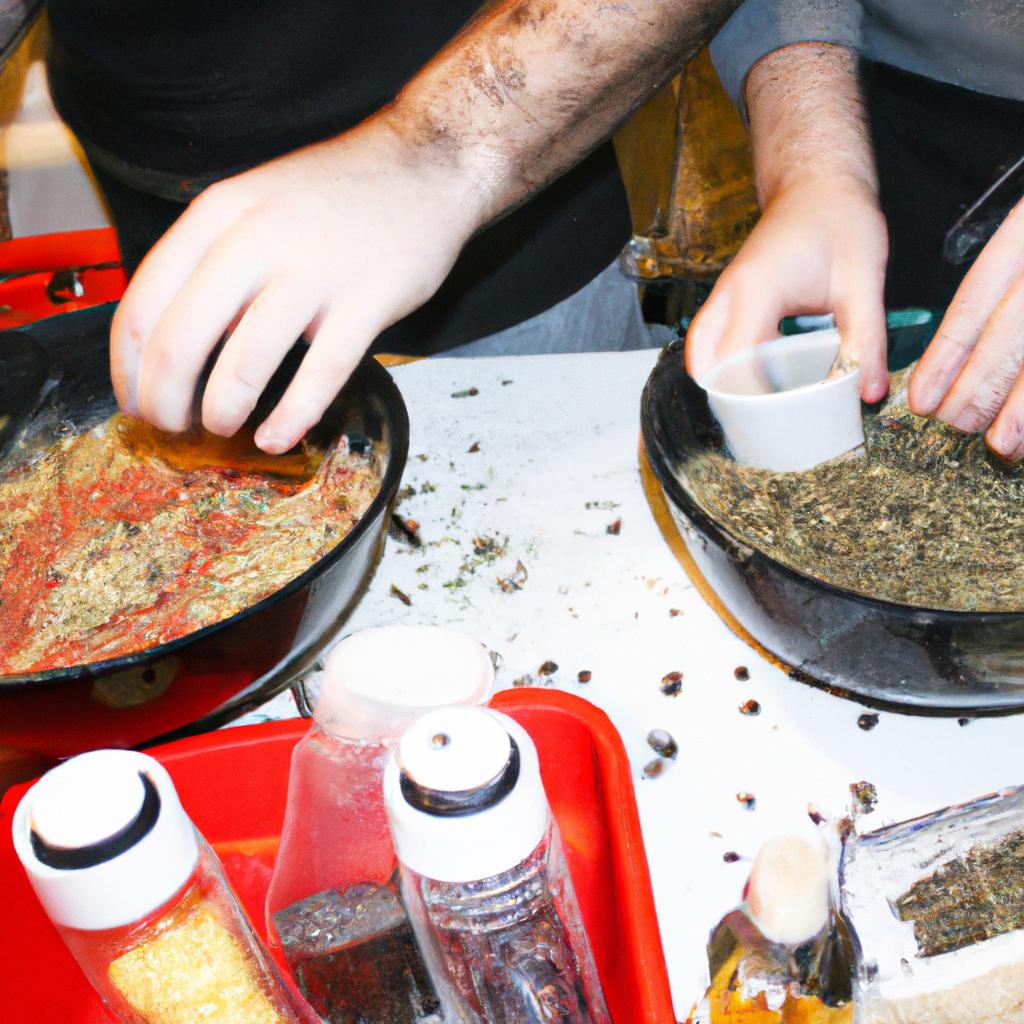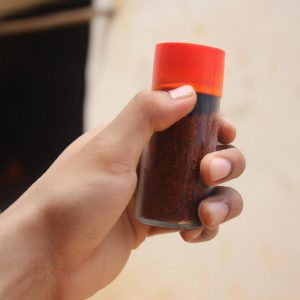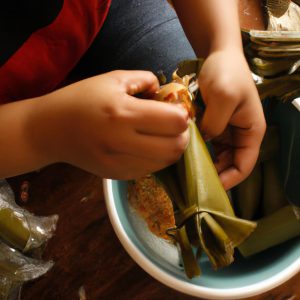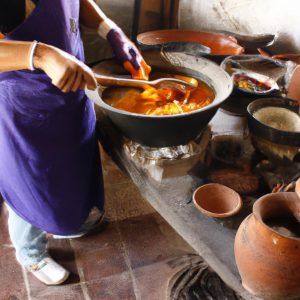Mexican cuisine is renowned for its rich and diverse flavors, which are largely attributed to the creative use of spices and seasonings. These culinary elements play a vital role in enhancing the taste profile of Mexican dishes, adding layers of complexity and depth. For instance, consider the case of mole poblano, a traditional Mexican sauce that combines numerous ingredients such as chocolate, chili peppers, cinnamon, and various other spices. This combination creates a harmonious blend of sweet, spicy, and savory flavors that tantalize the taste buds.
Spices and seasonings are not merely used for their flavor-enhancing properties in Mexican cuisine; they also hold cultural significance. They have been an integral part of Mexican culinary traditions for centuries, passed down through generations as ancestral knowledge. The indigenous people of Mexico were early pioneers in harnessing the power of these aromatic substances, utilizing them both as medicinal remedies and flavor enhancers in their cooking practices. Today, the influence of these ancient traditions can still be seen in modern Mexican kitchens where cooks continue to rely on an assortment of herbs and spices to create authentic and unforgettable dishes.
In this article, we will delve deeper into the world of spices and seasonings in Mexican cuisine. We will explore the key ingredients commonly used in traditional Mexican recipes and how they contribute to the unique flavors and aromas that define Mexican cooking.
One of the most iconic spices used in Mexican cuisine is Chili Pepper. From mild to fiery, there is a wide range of chili peppers available, each with its own distinct flavor profile. Common varieties include jalapeno, serrano, poblano, and chipotle. These peppers can be used fresh, dried, or smoked, adding heat and depth to dishes such as salsas, stews, and marinades.
Cumin is another essential spice in Mexican cuisine. It has a warm and earthy flavor that pairs well with beans, meats, and vegetables. Cumin seeds are often toasted before grinding to release their full aroma. Ground cumin is commonly found in dishes like tacos, enchiladas, and chili con carne.
Mexican oregano is a variety of oregano native to Mexico and has a slightly citrusy and floral taste compared to Mediterranean oregano. It is frequently used in Mexican soups, sauces, and meat dishes like barbacoa or carnitas.
Cilantro (coriander) is an herb widely used throughout Mexico for its vibrant flavor and aroma. Its leaves are often added as a garnish or incorporated into salsas and guacamole to provide a fresh and citrusy note.
Other popular herbs and spices in Mexican cuisine include epazote (used primarily in bean dishes for its digestive properties), cinnamon (used both in savory dishes like mole sauce as well as sweet treats like churros), cloves (often found in marinades for meats like cochinita pibil), and annatto seeds (used to give a vibrant red color to dishes like cochinita pibil).
It’s important to note that regional variations exist within Mexican cuisine when it comes to spice blends and seasonings. For example, the Yucatan region heavily utilizes achiote paste (made from annatto seeds) in their dishes, while the northern regions are known for incorporating a lot of garlic and black pepper.
In conclusion, spices and seasonings play a crucial role in Mexican cuisine by adding depth, complexity, and cultural significance to dishes. The creative use of ingredients like chili peppers, cumin, cilantro, and oregano contributes to the distinctive flavors that make Mexican food so beloved around the world. Whether it’s a simple salsa or a complex mole sauce, these spices and seasonings bring the vibrant spirit of Mexico to every bite.
Chili Powder as a Staple Spice
Chili Powder as a Staple Spice
When it comes to Mexican cuisine, one cannot overlook the significance of chili powder as a staple spice. Its vibrant red color and fiery taste add depth and complexity to countless dishes. For instance, imagine sinking your teeth into a plate of sizzling fajitas accompanied by a fragrant salsa that tantalizes your taste buds with its spicy kick. This delectable experience is made possible by the inclusion of chili powder, which plays an essential role in capturing the essence of Mexican flavors.
To fully grasp the importance of chili powder in Mexican cuisine, let us delve into its characteristics and versatile applications. Firstly, chili powder is typically composed of ground dried chilies blended with other spices such as cumin, garlic, and oregano. This combination creates a symphony of flavors that enhance the overall taste profile of various dishes. Secondly, this staple spice provides not only heat but also smoky undertones due to the roasting process involved in preparing the chilies before grinding them into powder form.
The culinary uses for chili powder are extensive and varied within Mexican gastronomy. From spicing up marinades for grilled meats to intensifying sauces for enchiladas or tamales, this versatile ingredient adds distinctive flavors that make every bite memorable. Moreover, chili powder can be used creatively beyond traditional recipes; sprinkle some on freshly cut fruits like mangoes or watermelons for an unexpected burst of sweet heat.
- Emphasize authenticity: Chili powder sourced from different regions imparts unique flavor profiles.
- Highlight health benefits: Contains capsaicin – known for boosting metabolism and providing anti-inflammatory benefits.
- Celebrate cultural heritage: Passed down through generations, preserving traditions and connecting communities.
- Evoke nostalgia: Reminiscent aromas take individuals back to cherished memories around family meals.
| Popular Dishes Enhanced by Chili Powder | Description |
|---|---|
| Enchiladas | Rolled tortillas filled with meat or cheese, topped with chili powder-infused sauce. |
| Pozole | Traditional Mexican soup made from hominy and pork, seasoned generously with chili powder. |
| Tacos al Pastor | Marinated pork cooked on a vertical spit, flavored with chili powder and served in soft corn tortillas. |
| Chiles Rellenos | Large poblano peppers stuffed with cheese or meat, coated in egg batter, and fried until golden brown. |
In conclusion, chili powder serves as an essential component of Mexican cuisine due to its vibrant color, fiery taste, and versatile applications. Whether used for spicing up traditional dishes or adding a unique twist to unconventional recipes, this staple spice captures the essence of Mexican flavors remarkably well.
Transitioning smoothly into the subsequent section about “The Earthy Flavor of Cumin,” it is evident that another key spice plays a crucial role in enhancing Mexican cuisine.
The Earthy Flavor of Cumin
Section: The Earthy Flavor of Cumin
After exploring the versatility and boldness of chili powder, we now turn our attention to another staple spice in Mexican cuisine: cumin. Known for its distinct earthy flavor, cumin adds depth and complexity to a wide range of dishes. Let us delve into the characteristics and culinary uses of this aromatic spice.
Cumin, scientifically known as Cuminum cyminum, is native to the eastern Mediterranean region but has been widely adopted by various cuisines worldwide. Its warm and nutty taste, with subtle hints of citrus and pepper, makes it an essential component in Mexican cooking. Take, for example, the traditional dish of carne asada tacos. Marinating the beef with a blend of spices that includes cumin infuses a deep richness into the meat, elevating its overall flavor profile.
The culinary applications of cumin extend beyond just adding taste; it also offers several health benefits. Here are some notable aspects associated with consuming this versatile spice:
- Digestive Aid: Cumin possesses carminative properties that can aid digestion by reducing bloating and flatulence.
- Antioxidant Powerhouse: It contains antioxidants like polyphenols and flavonoids that help protect against oxidative stress and inflammation.
- Iron Booster: Cumin is rich in iron which aids in maintaining healthy blood cells and preventing anemia.
- Potential Anti-Cancer Effects: Some studies suggest that certain compounds found in cumin may have anti-carcinogenic properties.
To better understand the significance of cumin in Mexican cuisine, let us examine how it compares to other key spices commonly used alongside it:
| Spice | Flavor Profile | Culinary Uses |
|---|---|---|
| Chili Powder | Bold, spicy, smoky | Salsas, marinades, seasoning meats |
| Oregano | Pungent, herbaceous | Soups, stews, sauces, meat rubs |
| Cumin | Earthy, warm, nutty with citrus undertones | Tacos, enchiladas, chili con carne |
As we can see from the table above, cumin’s earthiness complements the boldness of chili powder and adds depth to various Mexican dishes. This combination creates a harmonious balance of flavors that is characteristic of this vibrant cuisine.
Transitioning into our next section about “The Fragrant Herb: Oregano,” let us continue our exploration of the aromatic spices that define the rich tapestry of Mexican flavors. By understanding each spice’s unique characteristics and culinary applications, we gain deeper insight into the artistry behind authentic Mexican cooking.
The Fragrant Herb: Oregano
Cumin is a versatile spice that adds an earthy and warm flavor to Mexican cuisine. With its distinct aroma and taste, cumin has become an essential ingredient in many traditional dishes. Let us explore the unique characteristics of cumin and its role in enhancing the flavors of Mexican cuisine.
One example showcasing the impact of cumin on Mexican dishes can be found in the popular dish called “Chili con Carne.” By adding just a pinch of cumin, this hearty stew transforms into a rich and flavorful delight. The earthiness of cumin pairs perfectly with the bold flavors of chili peppers and meat, creating a harmonious balance that tantalizes the taste buds.
To better understand why cumin holds such importance in Mexican cuisine, let’s delve into some key aspects:
- Aromatic properties: Cumin possesses a strong aromatic profile that enhances both smell and taste sensations. Its warming scent creates anticipation for the delicious meal about to be enjoyed.
- Digestive benefits: Cumin contains compounds that aid digestion by stimulating enzymes responsible for breaking down food. This not only improves overall gut health but also contributes to a more enjoyable dining experience.
- Versatile usage: Apart from being used as a standalone spice, cumin blends seamlessly with other spices like coriander, paprika, and turmeric, amplifying their flavors in various recipes.
- Nutritional value: In addition to its culinary uses, cumin provides numerous health benefits due to its rich content of antioxidants and minerals such as iron and manganese.
Below is a visual representation highlighting these aspects:
| Aspect | Description |
|---|---|
| Aromatic | Invokes anticipation through its strong fragrance |
| Digestive | Facilitates digestion process |
| Versatile | Enhances other spices’ flavors |
| Nutritious | Packed with antioxidants and essential minerals |
In summary, cumin plays an integral role in Mexican cuisine by adding an earthy flavor that elevates various dishes. Its aromatic properties create anticipation, while its digestive benefits contribute to overall well-being. Furthermore, the versatile usage of cumin allows it to enhance other spices’ flavors, making every meal a memorable experience.
Transitioning into the next section about “The Vibrant Red Paprika,” we delve deeper into another spice that brings vibrancy and depth to Mexican cuisine.
The Vibrant Red Paprika
The Fragrant Herb: Oregano
As we delve deeper into the realm of spices and seasonings in Mexican cuisine, we now turn our attention to one of the most aromatic herbs used extensively in this culinary tradition – oregano. With its distinct fragrance and flavor profile, oregano plays a vital role in enhancing the taste and aroma of various dishes.
Imagine yourself sitting at a vibrant Mexican restaurant, ordering a plate of sizzling fajitas. As the dish arrives at your table, you can’t help but notice the tantalizing scent wafting through the air. This is where oregano comes into play – its earthy and slightly bitter notes infuse the marinated meat with a robust flavor that elevates each bite.
To truly appreciate the versatility of oregano in Mexican cuisine, let’s explore some key aspects:
1. Traditional Usage: Oregano has been an integral part of Mexican cooking for centuries, dating back to ancient civilizations such as the Aztecs and Mayans. It serves as a foundation for many traditional spice blends like adobo seasoning or mole sauce.
2. Culinary Pairings: Oregano pairs exceptionally well with other prominent flavors found in Mexican cuisine, such as cumin, chili powder, garlic, and lime. These combinations create a harmonious symphony on your palate that embodies the essence of authentic Mexican dishes.
3. Health Benefits: Beyond its culinary applications, oregano also offers numerous health benefits. Rich in antioxidants and essential oils, it possesses antimicrobial properties that aid digestion and support overall immune system function.
Now let’s take a moment to reflect upon the significance of oregano by examining these emotional responses associated with it:
- Comfort: The familiar scent of oregano evokes feelings of warmth and comfort reminiscent of home-cooked meals shared with loved ones.
- Nostalgia: For those with Mexican heritage or fond memories of traveling to Mexico, the aroma of oregano can transport them back to vibrant marketplaces and bustling street food stalls.
- Excitement: The use of oregano in Mexican cuisine adds an element of excitement and anticipation as it introduces a unique flavor dimension to each dish.
- Appreciation: Understanding the cultural significance and traditional usage of oregano fosters appreciation for the historical roots and culinary heritage associated with this herb.
To further illustrate its versatility, here’s a table showcasing different dishes where oregano takes center stage:
| Dish | Oregano Usage |
|---|---|
| Chicken Enchiladas | Sprinkle dried oregano over the sauce before baking |
| Salsa Verde | Combine fresh oregano leaves with roasted tomatillos |
| Carne Asada Tacos | Marinate the beef overnight with garlic, lime, and oregano |
| Black Bean Soup | Simmer dried oregano alongside black beans for added depth |
As we conclude our exploration of oregano’s role in Mexican cuisine, let us now move forward into our next section. Prepare your taste buds for an encounter with coriander – a citrusy and floral herb that brings a refreshing twist to many beloved dishes.
Coriander: Citrusy and Floral
The Vibrant Red Paprika: A Burst of Flavor and Color
Imagine walking into a traditional Mexican restaurant, the air filled with tantalizing aromas. As you take your seat, a plate of sizzling fajitas is placed in front of you, adorned with colorful vegetables and succulent pieces of meat. You reach for the small shaker on the table, containing a spice that will elevate the dish to new heights – paprika.
Paprika, derived from grinding dried peppers into a fine powder, adds not only vibrant red hues but also depth and complexity to many Mexican dishes. Its rich smoky flavor can be mild or spicy, depending on the variety used. This versatile spice has found its way into countless recipes across Mexico, offering an essential component in creating authentic flavors.
When it comes to understanding the significance of paprika in Mexican cuisine, consider these four key aspects:
-
Visual Appeal: The bright red color of paprika instantly catches our attention and piques our curiosity about what lies beneath its fiery surface. It entices us visually and prepares our taste buds for a flavorful adventure.
-
Complexity of Flavors: Paprika’s distinct smokiness brings out various layers of taste when combined with other ingredients. It enhances the natural sweetness of tomatoes while adding subtle heat to stews and sauces.
-
Regional Variations: Just as different regions of Mexico boast their own unique culinary traditions, so too do they have specific preferences when it comes to paprika usage. Some areas favor using smoked variants such as chipotle Paprika for an intense kick, while others may opt for milder versions like sweet Hungarian paprika.
-
Cultural Significance: Beyond its gastronomic role, paprika holds cultural value in Mexican cuisine. It represents tradition and connects generations through shared meals prepared with love and care.
Table: Different Types of Paprika Found in Mexican Cuisine
| Type | Description | Flavor Profile |
|---|---|---|
| Sweet Paprika | Mild and slightly sweet | Subtle, earthy |
| Smoked Paprika | Intense smoky flavor | Bold, robust |
| Hot Paprika | Fiery heat with a touch of sweetness | Spicy, tangy |
| Chipotle Paprika | Smoked jalapenos ground into fine powder | Smoky, medium heat |
As we delve deeper into the world of Mexican spices and seasonings, it becomes evident that paprika plays an integral role. Its vibrant color captivates our senses while its complex flavors add depth to dishes. Now, let us explore another essential ingredient in Mexican cuisine – coriander: citrusy and floral.
Garlic Powder for an Intense Kick awaits as we take the next step on this flavorful journey through Mexican culinary traditions.
Garlic Powder for an Intense Kick
From the citrusy and floral notes of coriander, we now move on to explore another essential spice in Mexican cuisine: garlic powder. Known for its intense kick, this seasoning adds a distinct flavor profile to many traditional dishes. Let’s delve deeper into the characteristics and uses of garlic powder in Mexican cooking.
Imagine biting into a savory enchilada filled with tender chicken, gooey cheese, and smothered in a rich red sauce. The moment you take your first bite, an explosion of flavors dances on your palate – the tanginess from the tomatoes, the earthiness of cumin, and that unmistakable punch from Garlic Powder. It is this intensity that sets garlic powder apart as one of the go-to spices in Mexican cuisine.
So why do chefs consistently reach for garlic powder? Here are some key reasons:
- Versatility: Garlic powder effortlessly enhances various dishes such as salsas, marinades, soups, stews, and even grilled meats.
- Convenience: Unlike fresh garlic cloves which require peeling and mincing, garlic powder offers convenience without compromising taste.
- Long Shelf Life: With its extended shelf life compared to fresh garlic bulbs or minced garlic jars, garlic powder can be kept handy for longer periods.
- Consistency: Garlic powder provides consistent potency throughout different recipes, ensuring a reliable level of flavor every time it is used.
To better understand the impact of using this spice in Mexican cuisine, let’s take a closer look at how it compares to other common seasonings found in typical dishes:
| Seasoning | Flavor Profile | Common Uses |
|---|---|---|
| Coriander Powder | Citrusy and Floral | Salsas, marinades |
| Garlic Powder | Intense Kick | Enchiladas, soups |
| Cumin | Earthy and Nutty | Tacos, chili |
| Paprika | Smoky and Sweet | Chorizo, adobo seasoning |
As we can see from this table, garlic powder stands out for its bold flavor profile, adding a layer of intensity to dishes that other seasonings may not provide. Its distinct taste amplifies the overall experience of enjoying Mexican cuisine.
Incorporating garlic powder into traditional recipes allows us to appreciate the complexity of flavors within each dish. The intense kick it offers harmonizes with the citrusy notes of coriander and the earthiness of cumin, creating a perfect blend of spices in Mexican dishes.
Transitioning smoothly into our next section on “The Perfect Blend of Spices in Mexican Dishes,” let’s explore how these various seasonings come together to create culinary masterpieces bursting with rich and vibrant flavors.
The Perfect Blend of Spices in Mexican Dishes
Building on the intense kick provided by garlic powder, we now delve into the perfect blend of spices commonly used in Mexican dishes. This harmonious fusion creates a symphony of flavors that tantalize the taste buds and elevate the culinary experience.
The combination of various spices is crucial in Mexican cuisine, as it adds depth and complexity to dishes. Let’s consider an example – imagine biting into a savory taco seasoned with a medley of cumin, paprika, oregano, and chili powder. The earthy warmth from cumin intermingles with the smoky undertones of paprika, while the aromatic notes of oregano complement the subtle heat brought forth by chili powder. Together, these spices create a harmony that enhances each ingredient and transforms an ordinary dish into something extraordinary.
To better understand the significance of spice blends in Mexican cuisine, let’s explore some key aspects:
-
Traditional Spice Mixes:
- Adobo: A versatile blend consisting of dried chilies, garlic, vinegar, herbs like thyme or bay leaf.
- Sazon: An essential seasoning mix combining elements such as ground annatto seeds for color and flavor enhancement.
- Mole: A complex sauce often made with up to 30 ingredients including multiple types of dried chilies, nuts, seeds, chocolate,
and various spices.
-
Regional Variations:
Different regions within Mexico have their own unique spice blends influenced by local ingredients and cultural traditions.
For instance:Region Signature Blend Yucatan Recado Rojo (achiote paste) Oaxaca Mole Negro (black mole) Veracruz Jalapeño-based adobos -
Enhancing Flavor Profiles:
Spices not only provide heat but also enhance other flavors in Mexican cuisine. For example, the warmth of cinnamon can balance
the acidity of tomatoes in salsas or complement the sweetness of chocolate in mole sauces.
Incorporating a diverse range of spices and seasonings into Mexican dishes elevates them from ordinary to extraordinary. The careful combination of flavors creates a culinary experience that is both vibrant and satisfying. In our next section, we will explore the origins of chili powder, an essential component in many traditional Mexican recipes.
As we continue our exploration, let’s dive deeper into the fascinating world behind one particular spice – chili powder
Exploring the Origins of Chili Powder
Imagine biting into a warm, flavorful taco packed with layers of spices that awaken your senses. The distinct combination of flavors is what sets Mexican cuisine apart and makes it truly exquisite. In this section, we will delve deeper into the art of blending spices in Mexican dishes, exploring how different combinations create unique taste profiles.
One example of a well-balanced spice blend commonly used in Mexican cuisine is adobo seasoning. Adobo consists of various spices such as garlic powder, onion powder, oregano, cumin, and paprika. This versatile blend adds depth and complexity to meats like chicken or pork when used as a marinade. It perfectly exemplifies how carefully selected spices can enhance the overall flavor profile of a dish.
To further understand the importance of spice blends in Mexican cooking, let’s explore some key reasons why they are integral to creating authentic flavors:
- Complexity: Combining multiple spices creates layers of flavors that complement each other, resulting in a more complex and satisfying taste experience.
- Balance: Spice blends help achieve balance by harmonizing contrasting flavors like sweet and savory or spicy and tangy.
- Tradition: These blends often have deep cultural roots and are passed down through generations, preserving traditional culinary practices.
- Versatility: Spice blends can be used across various dishes, allowing chefs to experiment while maintaining an underlying essence of Mexican cuisine.
In addition to understanding the concept behind spice blends, visual aids can also provide valuable insights into their composition. Take a look at the table below showcasing some common ingredients found in popular Mexican spice mixes:
| Spice Mix | Key Ingredients |
|---|---|
| Taco Seasoning | Chili Powder, Cumin |
| Fajita Seasoning | Paprika, Garlic Powder |
| Mole Sauce | Chocolate, Cinnamon |
As you can see from these examples above, there is no shortage of diverse spice blends in Mexican cuisine. Each blend has its own unique combination of flavors, resulting in a wide array of tastes to explore.
Understanding the perfect balance and combinations of spices is crucial for achieving authentic Mexican flavors. In the subsequent section, we will focus on one such spice that plays a significant role in this culinary tradition: cumin. By delving into the origins and usage of cumin in Mexican cuisine, we can further appreciate its contribution to the rich tapestry of flavors found within this vibrant culinary heritage.
The Role of Cumin in Mexican Cuisine
Exploring the Origins of Chili Powder and its Influence on Mexican Cuisine
To truly understand the depth and complexity of Mexican cuisine, one must delve into the origins of chili powder. This versatile spice blend has played a significant role in shaping the flavors that define traditional dishes from this vibrant culinary heritage. By examining its history and impact, we can gain valuable insights into the evolution of Mexican cuisine.
For example, let us consider the case study of pozole, a beloved Mexican soup made with hominy and meat. The addition of chili powder gives it a distinctive heat that tantalizes the taste buds. It is fascinating to trace back how this fiery ingredient found its way into the bowl of pozole, adding an essential layer of flavor.
When examining the influence of chili powder on Mexican cuisine as a whole, several noteworthy aspects come to light:
- Cultural Exchange: Chili powder’s journey into Mexico involved encounters with various cultures throughout history – from indigenous civilizations to European colonizers. Each interaction contributed unique elements to its development.
- Regional Variations: Different regions within Mexico have their own interpretations and preferences when it comes to chili powder. From smoky chipotle peppers in Oaxaca to spicy árbol chilies in Veracruz, these regional variations offer diverse experiences for food enthusiasts.
- Pairing Possibilities: The versatility of chili powder allows it to be paired with an array of ingredients beyond meats and soups. Its presence can enhance salsas, marinades, dressings, and even desserts – showcasing its ability to elevate any dish.
- Culinary Identity: With its bold flavors deeply ingrained in Mexican gastronomy over centuries, chili powder stands as a symbol of cultural identity. It represents not only heat but also passion and pride associated with traditional cooking techniques.
As we reflect on the significance of chili powder in Mexican cuisine, it becomes evident that understanding spices’ historical context adds richness to our appreciation of culinary traditions. This exploration sets the stage for further investigation into cumin’s role in Mexican cooking, revealing yet another layer of flavor waiting to be unraveled.
Transitioning seamlessly into the subsequent section on “Oregano: A Must-Have Herb in Mexican Cooking,” we embark upon a journey through the vibrant world of herbs that accompany chili powder and cumin, adding depth and complexity to traditional Mexican dishes.
Oregano: A Must-Have Herb in Mexican Cooking
In the previous section, we explored the significance of cumin in Mexican cuisine. Now, let’s shift our focus to another essential herb: oregano. Oregano is a versatile and widely used herb that adds depth and complexity to various dishes in Mexican cooking.
To illustrate its importance, consider this hypothetical scenario: Imagine you are sitting down at a traditional Mexican restaurant, eagerly waiting for your meal to arrive. As you take in the vibrant colors and enticing aromas around you, one dish catches your attention – a hearty bowl of pozole, a traditional Mexican soup made with hominy and meat. The rich flavors of the broth fill your senses as you take your first spoonful. Amongst the medley of tastes dancing on your palate, there is an underlying earthiness that ties everything together – that distinct flavor comes from none other than oregano.
Oregano plays a crucial role in enhancing the taste profile of many Mexican dishes. Here are some key qualities and uses of oregano in Mexican cooking:
- Aromatic Powerhouse: Oregano possesses strong aromatic properties that infuse dishes with its unique fragrance.
- Flavor Enhancer: Its robust flavor complements various ingredients like tomatoes, onions, garlic, chili peppers, and meats.
- Versatile Herb: Oregano can be used both dried and fresh – each form offering slightly different nuances to recipes.
- Culinary Applications: From salsas and marinades to soups and stews, oregano finds its way into numerous savory preparations.
To further understand the impact of oregano in Mexican cuisine, let’s take a closer look at how it compares to other popular herbs commonly used alongside it:
| Herb | Flavor Profile | Culinary Uses |
|---|---|---|
| Cilantro | Fresh, citrusy | Salsas, guacamole, salads |
| Epazote | Earthy, pungent | Bean dishes, soups |
| Bay leaf | Subtle and woody | Stews, braises |
As we can see from this comparison table, oregano brings its own distinct flavor to Mexican cuisine. Its versatility makes it a staple herb that elevates the taste of various dishes.
In summary, oregano is an indispensable ingredient in Mexican cooking. Whether used dried or fresh, it adds depth and complexity to diverse recipes. From fragrant salsas to hearty stews, oregano lends its unique flavors to create the vibrant tapestry of Mexican cuisine.
Transitioning into the next section about “Paprika: Adding Color and Flavor to Mexican Dishes,” let’s now explore another spice that plays a significant role in enhancing both the visual appeal and taste of traditional Mexican dishes.
Paprika: Adding Color and Flavor to Mexican Dishes
The Flavors: Spices and Seasonings in Mexican Cuisine
Section H2: Oregano: A Must-Have Herb in Mexican Cooking
Having explored the essential role of oregano in Mexican cuisine, we now turn our attention to another staple ingredient that adds both color and flavor to traditional dishes. Paprika, with its vibrant hue and distinctive taste, holds a special place in the culinary world of Mexico.
Paprika is not only known for its visual appeal but also for the depth it brings to various Mexican delicacies. For instance, imagine biting into a warm corn tortilla filled with tender chicken breast marinated in a blend of spices including paprika. The vivid red-orange powder infuses the meat with an earthy sweetness, enhancing each bite and creating a symphony of flavors on your palate.
To truly appreciate the impact of paprika on Mexican food, let us delve into some key characteristics and uses:
-
Colorful Culinary Palette:
- Paprika’s bright red tone adds vibrancy to dishes like pozole or enchiladas.
- It creates an eye-catching contrast against green cilantro or white cotija cheese.
-
Flavor Enhancer:
- With its subtly sweet and slightly smoky undertones, paprika elevates everything from spicy chiles rellenos to hearty stews like mole poblano.
- Its versatility allows it to work harmoniously alongside other seasonings such as cumin or garlic.
-
Nutritional Benefits:
- Apart from being rich in antioxidants, paprika contains vitamins A, E, and C that contribute to overall well-being when incorporated into a balanced diet.
- These nutritional properties make it more than just a flavorful addition; it becomes part of a health-conscious approach to cooking.
-
Cultural Significance:
| Dia de los Muertos | Paprika is often used to decorate traditional sugar skulls during the Day of the Dead celebrations, adding a vibrant touch to these symbolic creations. |
| Fiesta Atmosphere | The presence of paprika-infused dishes at gatherings and fiestas heightens not only the visual appeal but also contributes to the festive atmosphere that characterizes Mexican culture. |
| Memorable Experiences | From enjoying street tacos seasoned with paprika-spiced grilled meats in bustling markets to savoring complex moles in elegant restaurants, paprika plays an integral role in creating memorable food experiences for locals and visitors alike. |
Incorporating this versatile spice into your culinary repertoire allows you to explore new dimensions of flavor while paying homage to the rich traditions of Mexican cuisine. So let us now embark on a journey through another key ingredient: coriander.
Discovering the Versatility of Coriander in Mexican Food
Transitioning from the previous section on paprika, we now turn our attention to another essential spice in Mexican cuisine: coriander. Known for its versatility and distinct flavor profile, coriander plays a crucial role in enhancing the taste of various dishes. Let us delve deeper into this flavorful herb and discover its many uses in Mexican cooking.
To illustrate the significance of coriander, let’s consider an example where it is used as a key ingredient in salsa verde, a popular condiment in Mexican cuisine. Salsa verde typically consists of fresh tomatillos, onions, garlic, chili peppers, lime juice, and cilantro (the leaves of the coriander plant). The addition of coriander elevates the flavors by imparting a bright citrusy note and refreshing aroma that perfectly complements the tanginess of tomatillos.
When exploring the versatility of coriander in Mexican food, several noteworthy aspects come to light:
- Culinary Applications: Coriander can be used as both a whole seed or ground spice. It features prominently in marinades for meats like chicken and pork while also being an integral component of rubs for grilling or roasting.
- Herbal Medicine: In traditional medicine practices, coriander has been employed for its potential health benefits. Some claim that it aids digestion and may have anti-inflammatory properties.
- Global Cuisines: Although widely associated with Mexican cuisine, coriander finds extensive use across different culinary traditions worldwide. Its presence can be observed in Indian curries, Thai soups, Middle Eastern salads, and more.
- Variety Within Coriander: While most people are familiar with using only the leaves (cilantro), all parts of the coriander plant possess unique characteristics worth exploring—such as dried seeds providing warm earthy flavors desired in pickling or baking.
The following table showcases some common uses of coriander in various Mexican dishes:
| Dish | Coriander Usage |
|---|---|
| Guacamole | Chopped fresh cilantro for added freshness |
| Pozole | Ground coriander seeds in robust red broth |
| Tacos al Pastor | Marinated pork with coriander-infused sauce |
| Enchiladas Verdes | Sprinkled cilantro leaves over green salsa |
Through its diverse applications and distinct flavor profile, coriander continues to captivate taste buds around the world. Its ability to enhance the taste and aroma of Mexican dishes makes it an indispensable spice in this flavorful cuisine.
In summary, exploring the versatility of coriander reveals its significance as a key ingredient in Mexican cooking. From adding freshness to guacamole to infusing depth into pozole, coriander’s impact on these dishes cannot be overlooked. Whether used as whole seeds or ground spices, this herb brings a unique character that enhances the overall experience of savoring authentic Mexican flavors.











More Stories
Chili Powder: A Key Ingredient for Mexican Food Spices and Seasonings
Oregano in Mexican Cuisine: Spices and Seasonings Explained
Cumin: A Fundamental Mexican Spice